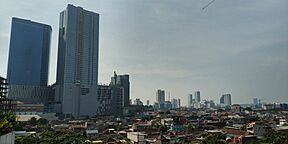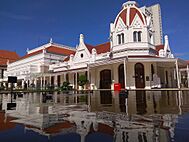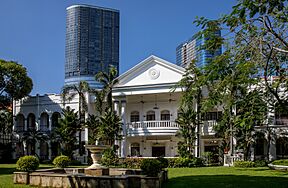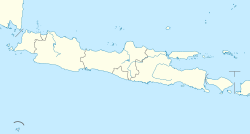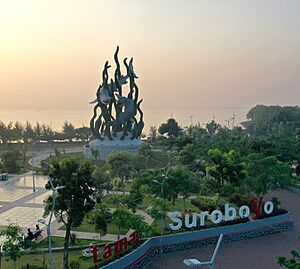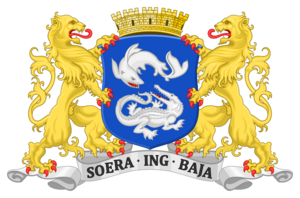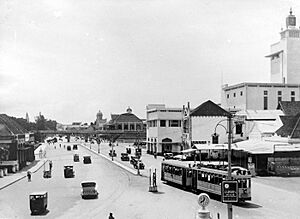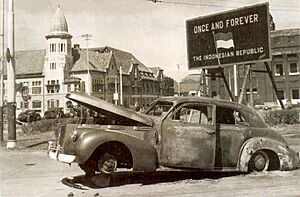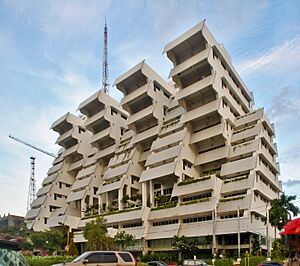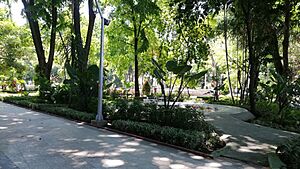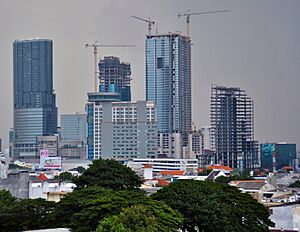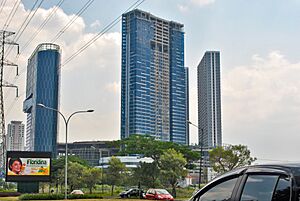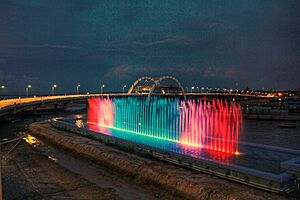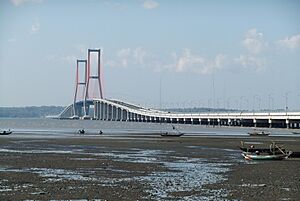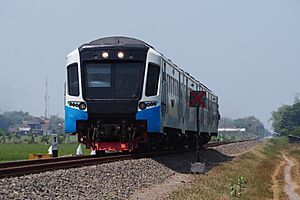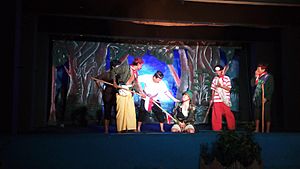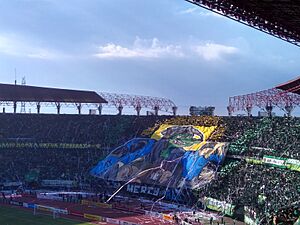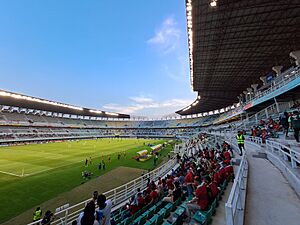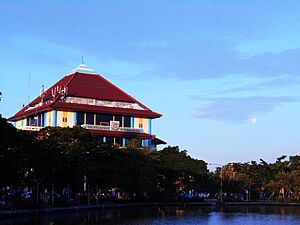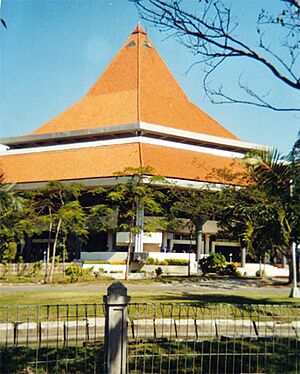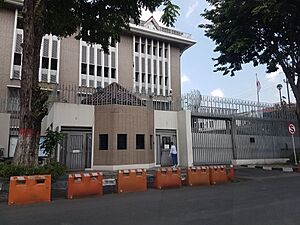Surabaya facts for kids
Quick facts for kids
Surabaya
|
|||
|---|---|---|---|
|
City
|
|||
| City of Surabaya Kota Surabaya |
|||
| Regional transcription(s) | |||
| • Javanese | Suråbåyå (Gêdrig) سورابايا (Pégon) ꦯꦸꦫꦨꦪ (Hånåcåråkå) |
||
| • Madurese | Sorbhâjâ (Latèn) سَوربۤاجۤا (Pèghu) ꦯꦺꦴꦂꦨꦗ (Carakan) |
||
| • Chinese | 泗水 Sìshuǐ (Pinyin) Sù-súi (Hokkien POJ) |
||
|
Downtown Surabaya
Balai Pemuda
Heroes Monument
Hotel Majapahit
|
|||
|
|||
| Nickname(s):
Kota Pahlawan (City of Heroes)
Kota Baya (Brave City) |
|||
| Motto(s):
Sura ing Baya (Kawi)
"Brave in the Face of Danger" |
|||
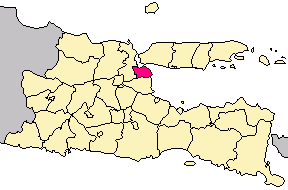
Location within East Java
|
|||
| Country | |||
| Region | Java | ||
| Province | |||
| Settled | 1037 | ||
| Founded | 31 May 1293 | ||
| Incorporated | 1 April 1906 (as Gemeente) | ||
| Government | |||
| • Type | Surabaya City Government | ||
| Area | |||
| • City | 350.56 km2 (135.35 sq mi) | ||
| • Urban | 911 km2 (352 sq mi) | ||
| • Metro | 5,925 km2 (2,288 sq mi) | ||
| Elevation | 5 m (16 ft) | ||
| Population
(mid 2023 estimate)
|
|||
| • City | 3,009,286 (2nd) | ||
| • Urban | 6,556,000 (3rd) | ||
| • Urban density | 7,134/km2 (18,480/sq mi) | ||
| • Metro | 9,958,656 (2nd) | ||
| • Metro density | 1,615/km2 (4,180/sq mi) | ||
| Demonyms | Surabayan | ||
| Demographics | |||
| • Ethnic groups (2017 estimates) |
List
|
||
| • Religion |
List
|
||
| Time zone | UTC+07:00 | ||
| Postal Code |
60111 – 60299
|
||
| Area code | (+62) 31 | ||
| Vehicle registration | L | ||
| Nominal GDP | 2023 | ||
| - Total | |||
| - Per capita | |||
| - Metro | |||
| - Growth | |||
| HDI (2023) | |||
| Largest district by area | Sukolilo – 30.15 square kilometres (11.64 sq mi) | ||
| Largest district by population | Tambaksari (226,136 – 2022 est) |
||
Surabaya is the capital city of East Java province in Indonesia. It is the second-largest city in Indonesia, right after Jakarta. Surabaya is located on the northeastern tip of Java island, by the Madura Strait. It has been an important port city in Southeast Asia for a very long time.
About 3 million people live in Surabaya, and over 10 million live in the larger Surabaya metropolitan area. This makes it the second-largest metropolitan area in Indonesia. Surabaya is also known as Kota Pahlawan, which means "City of Heroes." This nickname comes from its important role in Indonesia's fight for independence.
Surabaya is a busy trading city. It exports things like sugar, tobacco, and coffee. Its long history as a trading port means it has a strong financial system with many banks and companies. The city is also home to a large shipyard and special naval schools.
Contents
What's in a Name?
The name Surabaya comes from the Javanese language. It means "bravely facing danger." This name is linked to an old story about a fight between a giant white shark (sura) and a giant white crocodile (baya). This fight is seen as a symbol of bravery against danger.
Some people believe this story predicted a big battle on May 31, 1293. This was when the Majapahit kingdom fought against invaders. This date is now celebrated as the city's founding day. The shark and crocodile are now the city's official symbols. You can see them in a statue near the Surabaya Zoo.
Another story says the name comes from two heroes, Sura and Baya, who fought to rule the city. Many people in Surabaya love these stories, even if they are not proven.
Surabaya's Past
Early Beginnings
Surabaya's history goes way back to the 10th century. It was part of the Kingdom of Janggala. The earliest mention of Surabaya was in a Chinese book from 1225. It was called Jung-ya-lu back then.
By the 14th and 15th centuries, Surabaya was a key port for the Majapahit kingdom. A Chinese explorer named Ma Huan visited in the early 1400s. He wrote about Surabaya as a busy trading port.
Pre-Colonial Era
The Surabaya area was the main entry point to the Majapahit Kingdom from the sea. The city's anniversary, May 31, 1293, celebrates a victory. This was when Majapahit, led by Raden Wijaya, defeated invaders. The invaders from the sea were like the "sura" (shark/brave). Raden Wijaya's troops from land were like the "baya" (crocodile/danger). This is why the victory day is called Surabaya's anniversary.
Around the late 15th century, Islam started to grow in Surabaya. A famous Islamic teacher, Sunan Ampel, built a settlement and mosque there. Surabaya became a powerful area in eastern Java. It was a major trading port because of its location on the Brantas River delta. It was also on the trade route between Malacca and the Spice Islands.
Later, the Mataram Sultanate took over Surabaya in 1625. This was a tough fight for Mataram. With this victory, Mataram controlled most of Java.
Colonial Times
The Dutch East India Company took control of Surabaya in 1743. During the 18th and 19th centuries, Surabaya became the largest city in the Dutch East Indies. It was a major trading hub and had the biggest naval base. Surabaya was also a center for Java's plantation economy and industries.
In 1905, Surabaya became a municipality. In 1926, it was named the capital of East Java province. The city grew into the second-largest city in the Dutch East Indies. A modern port, Tanjung Perak Harbor, was built in 1910.
Independence Era
Japan occupied Surabaya in 1942 during World War II. After Japan surrendered, Indonesian nationalists took over the city. But then, they had a conflict with the British forces.
The Battle of Surabaya began on October 30, 1945. It started after a British general was killed. The Allies told the Indonesian fighters to surrender, but they refused. The battle on November 10 cost many lives. Indonesians now celebrate this day as Hari Pahlawan (Heroes' Day). This battle was very important for inspiring support for Indonesian independence. That's why Surabaya is called the "City of Heroes."
Modern Surabaya
After Indonesia gained independence, Surabaya grew rapidly. It expanded to the east and west. More vehicles and new industries led to traffic jams. However, Surabaya has also become one of the most organized cities in Indonesia. It is known for having very clean air.
In May 2018, there were some unfortunate events where churches and an apartment complex were bombed. This resulted in some deaths and injuries. The first case of COVID-19 in East Java was in Surabaya in March 2020. In May 2020, Surabaya became a center for the pandemic in Indonesia.
City Layout and Design
Surabaya covers about 350 square kilometers. Its larger metropolitan area is much bigger, covering over 6,300 square kilometers. This area includes nearby cities like Mojokerto, Gresik, and Sidoarjo. About 9.96 million people live in this metropolitan area. This makes it the second-largest urban area in Indonesia.
Surabaya is a very developed city. It offers many job opportunities. This attracts people from all over Indonesia, making it a mix of many cultures. The city is also known for being one of the cleanest and greenest in Indonesia.
Buildings and Architecture
Surabaya's buildings show a mix of styles. You can see colonial, Asian, Javanese, and modern influences. Many old colonial buildings from the 17th to early 20th centuries still stand. These include Hotel Majapahit and the Surabaya Post Office. They show Dutch and European styles.
Before World War II, many two-story shops were in the old city. They mixed European and Chinese designs. Some old buildings are now protected as cultural heritage sites. These are found around streets like Kembang Jepun and Rajawali.
After Indonesia became independent, Surabaya's building growth focused on the Jembatan Merah area. In the late 1990s and early 2000s, modern buildings started to appear. Surabaya is now a center for skyscrapers and tall buildings in East Java. Some of the tallest include The Peak Residence and One Icon Residence.
Parks and Green Spaces
Surabaya is one of Indonesia's cleanest and greenest cities. It has many urban parks with fountains. Some popular parks are Bungkul Park, Harmoni Park, and Pelangi Park. Bungkul Park won the Asian Townscape Award in 2013. It was recognized as the best park in Asia for its complete facilities. These include food centers, green areas, and free Wi-Fi.
The city has won many awards for its environment and city planning. These include national and international awards like Adipura and Adiwiyata. Surabaya has won the Adipura Cup many times for being a clean city. In 2011 and 2014, it won the ASEAN Environmentally Sustainable City Award. In 2018, Surabaya received the Lee Kuan Yew City Prize. This was for its excellent management of villages within the city.
Weather in Surabaya
Surabaya has a tropical wet and dry climate. This means it has clear wet and dry seasons. The wet season is from October to May. The dry season is from June to September. Temperatures are pretty steady all year. The average high is about 31°C, and the average low is around 23°C. The wettest months are December to February. The hottest months are September to November.
People and Culture
| Historical population | ||
|---|---|---|
| Year | Pop. | ±% |
| 1945 | 618,000 | — |
| 1950 | 715,000 | +15.7% |
| 1961 | 1,008,000 | +41.0% |
| 1971 | 1,556,255 | +54.4% |
| 1980 | 2,008,335 | +29.0% |
| 1990 | 2,467,089 | +22.8% |
| 2000 | 2,610,519 | +5.8% |
| 2010 | 2,768,225 | +6.0% |
| 2020 | 2,874,314 | +3.8% |
| 2023 | 3,009,286 | +4.7% |
| Source: Various sources
1945–1961 : Surabaya: City of Work |
||
Surabaya is the second most populated city in Indonesia. In 2023, about 3 million people lived there. The larger metropolitan area, called Gerbangkertosusila, has over 12 million people. Surabaya is a very urbanized city. It has many industries and is a leading education center. Many students from all over Indonesia come to study here.
The city's population grows by about 2.2% each year. More people have moved to Surabaya from nearby towns and villages in East Java.
Diverse Ethnic Groups
Most people in Surabaya are Javanese, making up about 83% of the population. Madurese and Chinese people are also large groups, each around 7%. There are also Arabs and other ethnic groups.
Surabaya also has people from other parts of Indonesia. These include Sundanese, Minangkabau, Batak, Banjar, and Balinese people. Because it's a trade center, many foreigners, called expatriates, live in Surabaya. You can find Korean and Western communities there.
Unique Language
Most people in Surabaya speak a special dialect of Javanese called Suroboyoan. This dialect is known for being direct and equal in speech. It mixes Indonesian and Javanese words. It also has some influence from Madurese.
The Suroboyoan dialect is used in local TV shows, radio, newspapers, and traditional plays called Ludruk. People who speak Suroboyoan are proud of their unique way of talking.
Religions in Surabaya
Religion in Surabaya (2019 Census) Islam (82.49%) Protestantism (11.90%) Roman catholic (3.91%) Buddhism (1.42%) Hinduism (0.25%) Confucianism (0.02%) Others (0.01%)
About 80% of Surabaya's citizens follow Islam. Other major religions include Christianity (Catholic and Protestant). Most Christians are Chinese Indonesians, Javanese, Bataks, and Ambonese.
Hinduism has a strong influence on Surabaya's culture. However, only a small number of people, mostly Indian and Balinese, practice it. Many Chinese Indonesians follow Buddhism and Confucianism. There was once a small community of Jews in the city.
Surabaya was an important Islamic center in Java. The famous Islamic figure Sunan Ampel is buried there. His tomb is a sacred site for pilgrims. The largest Muslim organization in Indonesia, Nahdlatul Ulama, was founded in Surabaya in 1926. Al-Akbar Mosque is the largest mosque in the city.
There are about 15 churches in Surabaya. The Church of the Birth of Our Lady was built in 1815. It is the first church in Surabaya and one of the oldest in Indonesia. Graha Bethany Nginden is one of the largest churches in Southeast Asia.
Surabaya's Economy
Since the early 1900s, Surabaya has been a very important trading port in Asia. It exports sugar, tobacco, and coffee. Its long history as a trading city has created a strong financial system. This includes many banks and export-import companies. The economy is growing thanks to international industries and the Suramadu Bridge.
The city is home to a large shipyard and special naval schools. The Bank of Indonesia plans for Surabaya to become Indonesia's Islamic financial center.
As the capital of East Java, Surabaya has many offices and business centers. It is the hub for economic, financial, and business activities in East Java. Surabaya is also Indonesia's second-largest port city after Jakarta. It serves as a trade center for East Java and other regions like Kalimantan. Surabaya's location makes it a key trading hub in Southeast Asia. The city is building many tall buildings like apartments and hotels to attract foreign money. Surabaya is one of the fastest-growing economic areas in Indonesia.
Most people in Surabaya work in services, industry, and trade. Major industries include shipbuilding, food processing, electronics, and handicrafts. Many big companies are based in Surabaya, such as Sampoerna and Unilever Indonesia.
Shopping in Surabaya
Surabaya has many places to shop. These range from traditional markets to modern shopping malls. You can find local and international brands in the malls. By the end of 2016, Surabaya had about one million square meters of retail space. There are also special markets for electronics and computer parts.
Some of the important shopping malls are Ciputra World Surabaya, Galaxy Mall, and Tunjungan Plaza. Pakuwon Mall is one of the largest malls in Surabaya and Indonesia.
Getting Around Surabaya
The number of roads in Surabaya has not grown as fast as the number of vehicles. This causes traffic jams. To help with this, the city government has built new roads. One example is the frontage road on Ahmad Yani road. They also completed the Middle East Ring Road (MERR). This road connects the Suramadu Bridge and Juanda International Airport. The 780-meter Suroboyo Bridge, which crosses the sea, is now a tourist attraction.
The city is also building two new ring roads: the Outer East Ring Road (OERR) and the West Outer Ring Road (WORR). These roads will connect different parts of the city and important locations like the Suramadu Bridge and Teluk Lamong Harbor. The city has also built underpasses and pump houses to reduce traffic and prevent flooding. Surabaya has also created bicycle lanes and pedestrian paths for people to use.
Major Highways
Surabaya is connected to other cities by several highways. These include the Surabaya-Gresik Toll Road and the Surabaya-Mojokerto Toll Road. The Surabaya-Gempol Toll Road connects Surabaya to the southern part of the province. The Waru-Juanda Airport Toll Road connects the city to the airport.
The Suramadu Bridge connects Surabaya to Madura Island. It is Indonesia's longest sea bridge. A new highway is planned from the bridge to a seaport in Madura. This new port will help ease the load on Surabaya's busy Tanjung Perak Port.
Public Transport
Surabaya has good land and sea transport. Juanda International Airport handles flights for passengers and cargo. Within the city, people mostly use cars, motorcycles, and taxis. There are also public buses. Surabaya is a transit city for ground transport between Jakarta and Bali. In 2018, the Trans-Java Toll Road was completed. This connects Jakarta and Surabaya with expressways.
Surabaya has three main train stations: Surabaya Kota, Surabaya Pasar Turi, and Surabaya Gubeng. The Argo Bromo Anggrek train connects Surabaya to Jakarta. The Surabaya commuter rail has 7 lines. These connect Surabaya to nearby areas like Lamongan and Mojokerto. Surabaya will also be the final stop for a new high-speed rail line from Jakarta.
The main bus terminal is Purabaya Bus Terminal. Other ways to get around include city buses like Suroboyo Bus and Trans Semanggi Suroboyo. There are also shared taxis called Angkot. Since 2018, the Suroboyo Bus has a unique payment system. You can pay for your ride using plastic waste! This makes Surabaya one of the few cities in the world to do this.
Port of Tanjung Perak is Surabaya's main trading port. It is one of the busiest ports in Indonesia. It is very important for shipping goods and passengers to other islands in Eastern Indonesia.
Culture and Arts
Surabaya's Javanese culture is unique. It is more open and equal compared to other regions. Surabaya is known for several special art forms:
- Ludruk: A traditional drama that shows the daily lives of working-class people.
- Remo Dance: A traditional dance performed to welcome special guests.
- Kidungan: Musical poetry that often includes humor.
People in Surabaya also have unique ways of calling each other. They use arek or rek as a friendly call. For men, they use Cak, and for women, they use Ning. Each year, a "Cak & Ning Surabaya" competition is held. The winners become tourism ambassadors for the city.
The Cak Durasim Festival (FCD) is an annual art festival. It helps preserve the culture of Surabaya and East Java. The Surabaya Art Festival (FSS) also happens once a year. It features theater, dance, music, and art exhibitions.
Surabaya's culture is a mix of Javanese, Madurese, Arab, Indian, Malay, Chinese, and European influences. The Surabaya Cross Culture festival celebrates these different cultures.
Delicious Food
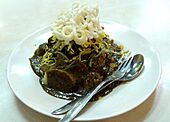
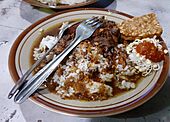
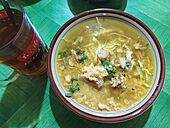

As a big city, Surabaya has all kinds of Indonesian cuisine and international restaurants. But foods from East Java are very popular here. Some famous East Javanese dishes include Rawon, Bakso Malang, and Pecel Madiun.
Surabaya is especially famous for:
- Rujak cingur: This dish has marinated cow snout or lips (cingur). It's served with boiled vegetables and shrimp crackers. It has a special sauce made from fermented shrimp paste (petis), peanuts, and chili. It's often eaten with lontong, which is a boiled rice cake.
- Rawon: A dark beef soup. Its dark color comes from kluwak nuts. It's served with bean sprouts and spicy chili sauce (sambal).
- Lontong kupang: lontong (rice cake) served with small cockles in a petis sauce.
- Semanggi: A salad made from boiled semanggi leaves. These leaves grow in rice fields. It has a spicy peanut sauce and is usually eaten with rice crackers.
Sports in Surabaya
Surabaya is a major center for association football (soccer) in Indonesia. Many football clubs were founded here. Gelora Bung Tomo Stadium is the home stadium of Persebaya Surabaya.
The first football club in Surabaya was founded in 1895. Later, in 1927, the Soerabajasche Indonesische Voetbalbond (SIVB) was founded. This club is now known as Persebaya. Persebaya has played against famous European teams like AC Milan and Ajax Amsterdam. They have also played against national teams from other countries.
NIAC Mitra, another team from Surabaya, won the Aga Khan Gold Cup in 1979. They also won the Main Football League three times. Persebaya has won the Indonesian League twice.
Persebaya has very loyal fans called Bonek. This name means "equipped by bravery." Surabaya is also home to CLS Knights Indonesia, a basketball club.
Badminton is another popular sport. Many schools and clubs in Surabaya train young players. Many famous badminton players started their careers in Surabaya.
Media and News
One of Indonesia's largest newspapers, Jawa Pos, has its main office in Surabaya. Other major newspapers include Surabaya Pagi and Surya.
Surabaya has many radio and television stations. Radio stations include RRI Surabaya and Suara Surabaya 100.0. Local TV stations are JTV, Jawa Pos TV, and Surabaya TV.
Education in Surabaya
Surabaya is a very popular place for education in Indonesia. It has about 40 higher education institutions. There are hundreds of public and private schools, including junior high schools, high schools, and vocational schools. The city has at least seventeen universities and sixty-four professional schools. These schools offer studies in science, technology, social sciences, and tourism.
Some of the major universities are:
- Universitas Airlangga (UNAIR): A top public research university.
- Sepuluh Nopember Institute of Technology (ITS): Focuses on science, engineering, and vocational education.
- State University of Surabaya (UNESA): A leading school for training teachers.
- Petra Christian University: One of Indonesia's oldest private Christian universities.
- Electronic Engineering Polytechnic Institute of Surabaya (PENS-PPNS): A major technical public institution.
- University of Surabaya: A private university offering psychology and pharmacy courses.
- Widya Mandala Catholic University: A private Catholic institution with healthcare studies.
Surabaya also has several international schools. These include Surabaya Intercultural School, Surabaya Japanese School, and Surabaya European School.
International Connections
Surabaya works with cities around the world. It also hosts several foreign government offices. This is because it is the second-largest city in Indonesia in terms of population and economy.
Diplomatic Offices
General Consulates
- Australian Consulate-General, Surabaya
- Chinese Consulate-General, Surabaya
- Consulate-General of Japan, Surabaya
- Consulate General of the United States, Surabaya
Consulates
- Austria
- Belarus
- Belgium
- Czech Republic
- Denmark
- East Timor
- Finland
- France
- Germany
- Hungary
- India
- Mongolia
- Netherlands
- New Zealand
- Philippines
- Poland
- Russia
- Slovakia
- Sri Lanka
- Switzerland
- Sweden
- Thailand
- United Kingdom
Other Diplomatic Offices
- Taiwan (Taipei Economic and Trade Office in Surabaya)
Sister Cities
Surabaya has "sister city" relationships with many cities worldwide. These partnerships help with cultural exchange and cooperation.
 Seattle, United States (1992)
Seattle, United States (1992) Busan, South Korea (1994)
Busan, South Korea (1994) Kōchi, Japan (1997)
Kōchi, Japan (1997) Monterrey, Mexico (2001)
Monterrey, Mexico (2001) Guangzhou, China (2005)
Guangzhou, China (2005) Xiamen, China (2008)
Xiamen, China (2008) Varna, Bulgaria (2010)
Varna, Bulgaria (2010) Liverpool, United Kingdom (2017)
Liverpool, United Kingdom (2017) New Delhi, India (2021)
New Delhi, India (2021) Shah Alam, Malaysia
Shah Alam, Malaysia Kaoshiung, Taiwan
Kaoshiung, Taiwan Alexandria, Egypt
Alexandria, Egypt Johor Bahru, Malaysia
Johor Bahru, Malaysia Jeddah, Saudi Arabia
Jeddah, Saudi Arabia Kuala Belait, Brunei
Kuala Belait, Brunei
Images for kids
See also
 In Spanish: Surabaya para niños
In Spanish: Surabaya para niños


